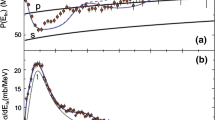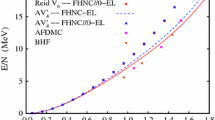Abstract
The structure of \(^{22}\)C plays a vital role in the new physics at subshell closure of \(N=16\) in the neutron-rich region. We study the two-neutron correlations in the ground state of the weakly-bound Borromean nucleus \(^{22}\)C sitting at the edge of the neutron-drip line and its sensitivity to \(\mathrm{core}\)-n potential. For the present study, we employ a three-body (\(\mathrm{core}+n+n\)) structure model designed for describing the Borromean system by explicit coupling of unbound continuum states of the subsystem (\(\mathrm{core}+n\)). We use a density-independent contact-delta interaction to describe the neutron-neutron interaction and its strength is varied to fix the binding energy. Along with the ground-state properties of \(^{22}\)C, we investigate its electric-dipole and monopole responses, discussing the contribution of various configurations. Our results indicate more configuration mixing as compared to the previous studies in the ground state of \(^{22}\)C. However, they strongly depend upon the choice of the \(^{20}\mathrm{C}\)-n potential as well as the binding energy of \(^{22}\)C, which call for new precise measurements for the low-lying continuum structure of the binary system (\(^{20}\mathrm{C}+n\)) and the mass of \(^{22}\)C. These measurements will be essential to understand the Borromean three-body system \(^{22}\)C with more accuracy.





Similar content being viewed by others
References
I. Tanihata, H. Hamagaki, O. Hashimoto, Y. Shida, N. Yoshikawa et al., Phys. Rev. Lett. 55, 2676 (1985)
M.V. Zhukov, B.V. Danilin, D.V. Fedorov, J.M. Bang, I.J. Thompson et al., Phys. Rep. 231, 151–199 (1993)
A. Ozawa, T. Kobayashi, T. Suzuki, K. Yoshida, I. Tanihata, Phys. Rev. Lett. 84, 5493 (2000)
N. Kobayashi, T. Nakamura, J.A. Tostevin, Y. Kondo, N. Aoi et al., Phys. Rev. C 86, 054604 (2012)
G. Audi, A.H. Wapstra, C. Thibault, Nucl. Phys. A 729, 337 (2003)
L. Gaudefroy, W. Mittig, N.A. Orr, S. Varet, M. Chartier et al., Phys. Rev. Lett. 109, 202503 (2012)
K. Yoneda, N. Aoi, H. Iwasaki, H. Sakurai, H. Ogawa et al., Phys. Rev. C 67, 014316 (2003)
K. Tanaka, T. Yamaguchi, T. Suzuki, T. Ohtsubo, M. Fukuda et al., Phys. Rev. Lett. 104, 062701 (2010)
Y. Togano, T. Nakamura, Y. Kondo, J.A. Tostevin, A.T. Saito et al., Phys. Lett. B 761, 412–418 (2016)
T. Nagahisa, W. Horiuchi, Phys. Rev. C 97, 054614 (2018)
W. Horiuchi, Y. Suzuki, Phys. Rev. C 74, 034311 (2006)
W. Horiuchi, Y. Suzuki, B. Abu-Ibrahim, A. Kohama, Phys. Rev. C 75, 044607 (2007)
B. Abu-Ibrahim, W. Horiuchi, A. Kohama, Y. Suzuki, Phys. Rev. C 77, 034607 (2008)
M.T. Yamashita, R.S. Marques de Carvalho, T. Frederico, Lauro Tomio, Phys. Lett. B 697, 90 (2011)
M.T. Yamashita, R.S. Marques de Carvalho, T. Frederico, Lauro Tomio, Phys. Lett. B 715, 282(E) (2012)
H.T. Fortune, R. Sherr, Phys. Rev. C 85, 027303 (2012)
S.N. Ershov, J.S. Vaagen, M.V. Zhukov, Phys. Rev. C 86, 034331 (2012)
B. Acharya, C. Ji, D.R. Phillips, Phys. Lett. B 723, 196 (2013)
K. Ogata, T. Myo, T. Furumoto, T. Matsumoto, M. Yahiro, Phys. Rev. C 88, 024616 (2013)
T. Inakura, W. Horiuchi, Y. Suzuki, T. Nakatsukasa, Phys. Rev. C 89, 064316 (2014)
Y. Kucuk, J.A. Tostevin, Phys. Rev. C 89, 034607 (2014)
T. Suzuki, T. Otsuka, C. Yuan, N. Alahari, Phys. Lett. B 753, 199 (2016)
L.A. Souza, E. Garrido, T. Frederico, Phys. Rev. C 94, 064002 (2016)
H.T. Fortune, Phys. Rev. C 94, 064307 (2016)
E.C. Pinilla, P. Descouvemont, Phys. Rev. C 94, 24620 (2016)
N.B. Shulgina, S.N. Ershov, J.S. Vaagen, M.V. Zhukov, Phys. Rev. C 97, 064307 (2018)
A.B. Migdal, Sov. J. Nucl. Phys. 16, 238 (1973)
S. Mosby, N.S. Badger, T. Baumann, D. Bazin, M. Bennett et al., Nucl. Phys. A 909, 69 (2013)
L. Fortunato, R. Chatterjee, J. Singh, A. Vitturi, Phys. Rev. C 90, 064301 (2014)
J. Singh, L. Fortunato, A. Vitturi, R. Chatterjee, Eur. Phys. J. A 52, 209 (2016)
J. Singh, Ph.D. thesis, University of Padova, Italy (2016), http://paduaresearch.cab.unipd.it/9278/
J. Singh, L. Fortunato, Acta Physica Polonica B 47, 1001 (2016)
N. Austern, Y. Iseri, M. Kamimura, M. Kawai, G.H. Rawitscher, M. Yahiro, Phys. Rep. 154, 125 (1987)
R.A.D. Piyadasa, M. Kawai, M. Kamimura, M. Yahiro, Phys. Rev. C 60, 044611 (1999)
H. Esbensen, G.F. Bertsch, K. Hencken, Phys. Rev. C 56, 3054 (1997)
A. Vitturi, F. Pérez-Bernal, Nucl. Phys. A 834, 428c (2010)
K. Hagino, A. Vitturi, F. Pérez-Bernal, H. Sagawa, J. Phys. G Nucl. Part. Phys. 38, 015105 (2011)
A. Ozawa, O. Bochkarev, L. Chulkov, D. Cortina, H. Geissel et al., Nucl. Phys. A 691, 599 (2001)
X.X. Sun, J. Zhao, S.G. Zhou, Phys. Lett. B 785, 530–535 (2018)
G.F. Bertsch, H. Esbensen, Ann. Phys. (N.Y.) 209, 327 (1991)
K. Hagino, H. Sagawa, Phys. Rev. C 72, 044321 (2005)
W. Horiuchi, Y. Suzuki, Phys. Rev. C 73, 037304 (2006)
W. Horiuchi, Y. Suzuki, Phys. Rev. C 74, 019901(E) (2006)
H. Esbensen, G.F. Bertsch, Nucl. Phys. A 542, 310 (1992)
Acknowledgements
We would like to thank P. Descouvemont and J. A. Lay for useful discussions. J. Singh gratefully acknowledged the financial support from Nuclear Reaction Data Centre (JCPRG), Faculty of science, Hokkaido University, Sapporo.
Author information
Authors and Affiliations
Corresponding author
Additional information
Publisher's Note
Springer Nature remains neutral with regard to jurisdictional claims in published maps and institutional affiliations.
This work was in part supported by JSPS KAKENHI Grant Numbers 18K03635, 18H04569 and 19H05140, and the collaborative research program 2019, information initiative center, Hokkaido University.
Appendix—Convergence with Model Parameters
Appendix—Convergence with Model Parameters
We calculate the continuum single-particle wave functions for different \(E_{\mathrm{\,cut}}\)’s. After fixing the convergence with \(E_{\mathrm{\,cut}}\), the continuum single-particle wave functions, using the mid-point method for \(E_{\mathrm{\,cut}}=5\) MeV, with \(\varDelta {E}=1.0\), 0.5, 0.2, 0.1, 0.08, 0.06 and 0.05 MeV, the two-particle states are formed and the matrix elements of the pairing interaction are calculated. The convergence of the results is discussed on two different levels:
-
1.
Convergence with the continuum energy cut (\(E_{\mathrm{\,cut}}\)) of the model space
We check the convergence of our results (dominant contribution in the ground state of \(^{22}\)C) with different \(E_{\mathrm{\,cut}}\)’s. In the Fig. 6a, we show the variation of three dominant contributions (\(s_{1/2}\), \(d_{3/2}\) and \(f_{7/2}\)) in the ground state of \(^{22}\)C with different \(E_{\mathrm{\,cut}}\)’s for different values of the energy spacing (\(\varDelta {E}\)). One can clearly see that we achieve the convergence with different \(E_{\mathrm{\,cut}}\)’s but still there is significant variation in the percentage contribution with different \(\varDelta {E}\)s. In the fourth quadrant of the Fig. 6a, due to huge computational costs, we restrict ourselves to only 10 MeV. It is convincing that one can choose fairly well the \(E_{\mathrm{\,cut}}=5\) MeV for this study and we will do all the calculations with \(E_{\mathrm{\,cut}}=5\) MeV.
-
2.
Convergence with the energy spacing (\(\varDelta {E}\)) of the model space
As seen from the Fig. 6b, we study the convergence of our results (dominant contribution in the ground state of \(^{22}\)C) with inverse of \(\varDelta {E}\) for \(E_{\mathrm{\,cut}}=5\) MeV. It is clear from the Fig. 6b, the curves start getting flat from \(\varDelta {E}=0.1\) MeV. Therefore, we adopt \(\varDelta {E}=0.1\) MeV (\(1/\varDelta {E}=10\) MeV) for the present calculations.
Rights and permissions
About this article
Cite this article
Singh, J., Horiuchi, W., Fortunato, L. et al. Two-Neutron Correlations in a Borromean \(\varvec{^{20}\mathrm{C}+n+n}\) System: Sensitivity of Unbound Subsystems. Few-Body Syst 60, 50 (2019). https://doi.org/10.1007/s00601-019-1518-8
Received:
Accepted:
Published:
DOI: https://doi.org/10.1007/s00601-019-1518-8





